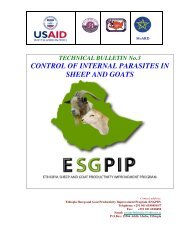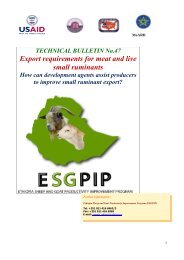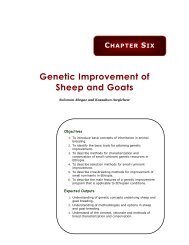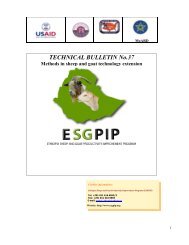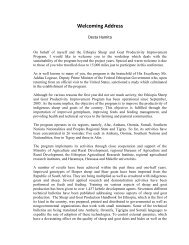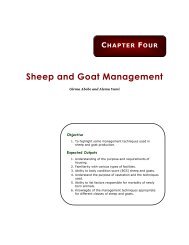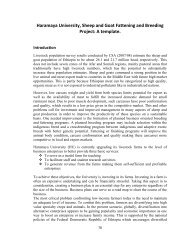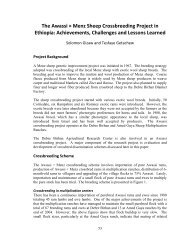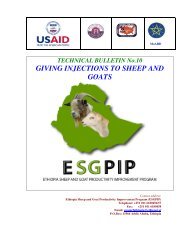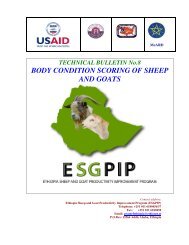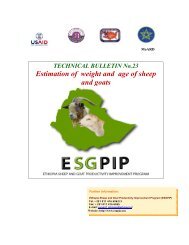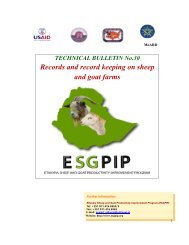TECHNICAL BULLETIN No.11 - esgpip
TECHNICAL BULLETIN No.11 - esgpip
TECHNICAL BULLETIN No.11 - esgpip
Create successful ePaper yourself
Turn your PDF publications into a flip-book with our unique Google optimized e-Paper software.
and water. It is recommended that the following guidelines be followed under such<br />
circumstances:<br />
o Rest the animals for a few hours in a dry, clean, sheltered area with access to<br />
fresh water after arrival. Then offer grass hay or mixed grass-legume hay.<br />
o Hand feed salt during the first two weeks; then provide trace mineral salt in<br />
a separate feeder. Afterwards, these supplements can be mixed in the<br />
complete diet, but salt should continue to be provided ad libitum (free<br />
choice).<br />
• Animals should have feed available at all times including evenings. If there is no<br />
feed left in the morning, feed supply should be increased for the following day.<br />
• Adjust the animals to the fattening concentrate diet over a two week period by<br />
feeding the concentrate after the animals have consumed enough roughage to<br />
provide bulk. Gradually increase the intake of the concentrate every two days, while<br />
providing free access to the basal roughage diet.<br />
• Sort the animals by weight/size/sex and feed in uniform weight/sex groups. Large<br />
animals tend to bully smaller animals and keep them away from feed troughs.<br />
• Cull non-performing animals. Some animals do not adapt to intensive feeding<br />
irrespective of breed, sex or age. It is best to cull these animals as soon as possible.<br />
They can be identified by their poor performance in the initial stages of feeding.<br />
• Feed for 90 to 120 days. The length of the feeding period depends upon the desired<br />
animal condition and the type of ration fed. What is desired for the export market<br />
may just be conditioning without the amount of fat desired by the local market.<br />
Thus, animals for export can be sold at a time when the desired condition is<br />
attained.<br />
• Water should be available at all times. Inadequate water supply will affect their<br />
performance.<br />
• The animals should have shelters that protect them from adverse environments. The<br />
shelter need not be expensive. Any building material will do, depending on<br />
availability and financing. The shelter can be constructed from locally available<br />
materials such as bamboo or mud with thatched roof. Space required is about 2 m 2<br />
per animal. Shelter should normally be open on one side. Walls up to 1.2 meters on<br />
the other three, with a gap of 0.5-0.8 meters between the walls and roof, to provide<br />
sufficient ventilation without draft. Muddy feedlots reduce feed efficiency<br />
drastically; it is thus necessary to keep the premises dry. Flooring should be<br />
included and elevated at least about 15 degrees to facilitate cleaning and drainage.<br />
Feeding racks (silage, water, mineral and concentrate) should be accessible to both<br />
goats and caretaker, preferably in the front of the aisle. A feeding space of 20 linear<br />
centimeters should be provided per animal.<br />
• Socio-economic considerations: Sheep and goats for fattening need to be purchased<br />
when prices are low and sold at times of peak demand when prices are high. Feeds<br />
should also be purchased when prices are lowest and stored. These measures are<br />
important in increasing the profit margin of the fattening operation.<br />
5.3. Health of fattening sheep and goats<br />
5



